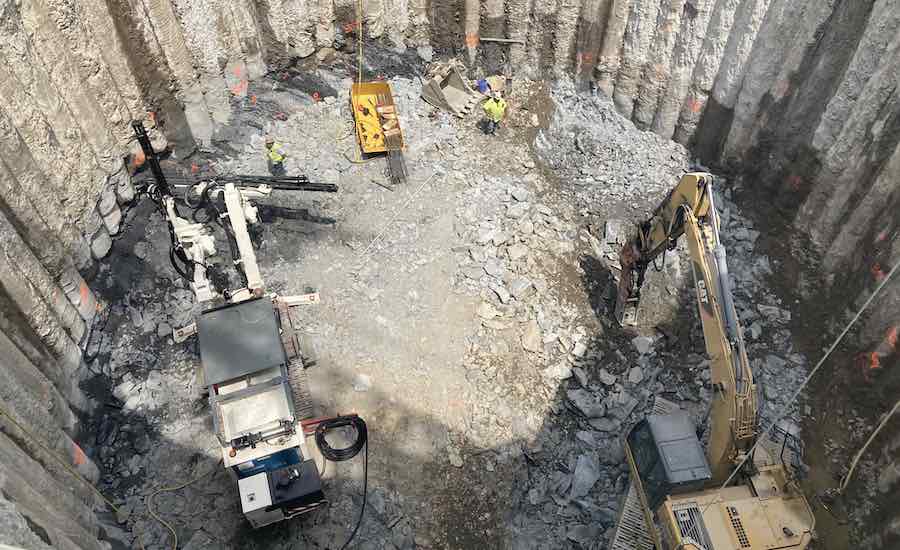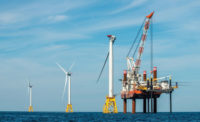A construction crew now is set to bore a massive tunnel near the Seekonk River in Pawtucket, R.I. in the third and final phase of Rhode Island’s “Big Dig.” The $1.5-billion Narragansett Bay Commission Combined Sewer Overflow (CSO) program is the largest single public works project in state history.
CB3A—a joint venture of contractors CBNA, a U.S. unit of French giant Bouygues and Barletta Construction LLC, Canton, Mass., with AECOM—are collaborating on the estimated $450-million design-build contract to be completed by 2027. Smaller components of this phase, which began last month, include an interceptor gate and screening structure, and will continue until 2041, according to a spokeswoman at Stantec, the lead designer and program manager for the final phase.
The Edmonton, Alberta-based firm is collaborating with Pare Corp., Lincoln, R.I.
The 2.2-mile-long, 30-ft dia. tunnel runs beneath Pawtucket and Central Falls at a depth ranging from 115 ft to 155 ft below grade. The facility will be able to store up to 58.5 million gallons of overflows, said a Stantec press statement in June. The tunnel is set to be operational in 2026 with final completion by 2027.
Initial Work
Hoping to launch the tunnel boring machine (TBM) in early summer 2022, CB3A is constructing the launch shaft and tunnel pump station shaft simultaneously, says Pete Williamson, deputy project manager for CB3A.
“The temporary support of excavation in soil, for both shafts, is complete and performing well,” Williamson says. The team is currently “excavating the rock portion of the [shaft] with ancillary work, including electrical and other utility feeds to support the TBM mining ongoing,” he adds.
CB3A will mine the tunnel with a Herrenknecht TBM, a dual mode machine capable of operating in both the open mode and earth pressure balance closed mode, the JV says. The rock bore diameter is 33.79 ft and final inside diameter is 30.17 ft.
During the tunnel procurement phase, CB3A proposed cost and time-saving concepts including raising the tunnel by 25 ft, tunnel liner ring design alternatives and relocation of the tunnel pump station and launch shaft, Stantec said.
One major challenge of the complex project n a dense urban environment “is to construct the multiple drop shafts, located throughout the tunnel’s 2.2-mile alignment,” Williamson says. “Each shaft is constructed in varying ground conditions and rigorous vetting of the design and constructability is needed, all while putting great weight on progressing construction activities in close proximity of local residents and stakeholders.”
Vincent J. Mesoleslla, chairman of owner/operator Narragansett Bay Commission, notes the project as “critical” for “the next generation of Rhode Islanders ... to only ever know a clean bay and vibrant urban rivers.”
The first part of final phase work, which began last month, is expected to shrink overflow volume by 98% and treat stormwater before it flows into the Narragansett Bay, said Stantec.
“With the frequency and intensity of storms on the rise, the time is now for communities to take action to protect human health and the environment,” says Melissa Carter, a Stantec vice president.
In addition to challenges associated with schedule and ongoing concerns about supply chain volatility, the team seeks a solution for how it will dispose of an estimated 840,000 tons of pulverized rock material excavated during tunnel mining, she says. “There’s limited opportunity for disposal or beneficial reuse of this material,” Carter says.
Despite the challenges, the team predits the phase will be completed on time, Carter says.
Benefits of Prior Work
The region is already showing signs of progress from earlier phase work.
“As a result of the first two phases of the program … we’ve seen about 85 extra shell fishing days a year and are anticipating similar benefits from this tunnel,” says Jamie Sammons, Commission public affairs manager. “We’ve seen shell fishing grounds in the upper Providence River that have been closed for 75 years have now been opened, in addition to more swimming beaches open upstream from the river; we are anticipating similar benefits from the second tunnel.”
Stantec and Pare have identified many cost savings measures for the project by utilizing proprietary WARi (Weighted Average Residential Index) methodology. Stantec developed its proprietary WARi method as “a more accurate representation using 53 data point in the Census tract instead of two traditionally used by the EPA [Environmental Protection Agency] to determine the cost burden on ratepayers,” Carter says.
The three-phase CSO program began in 2001 with construction of a three-mile long, 26-ft-wide deep-rock tunnel under Providence to store stormwater runoff. A prior phase finished in 2015 added CSO interceptors to the Providence Tunnel, several sewer-separation projects and a wetlands storage facility.
An additional 10-ft dia. stub tunnel project is set to begin in 2031 with construction to be started in 2035, Carter notes.






Post a comment to this article
Report Abusive Comment